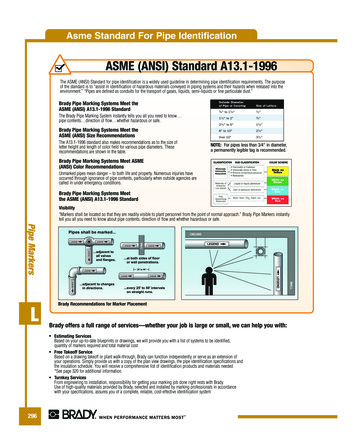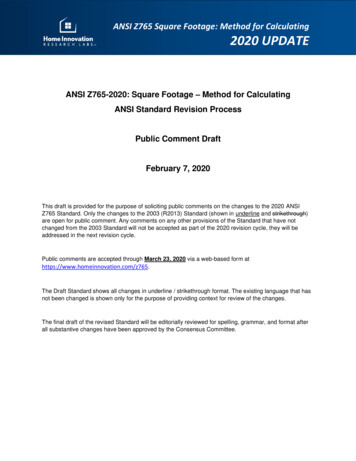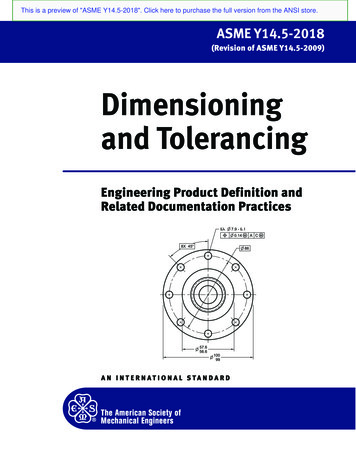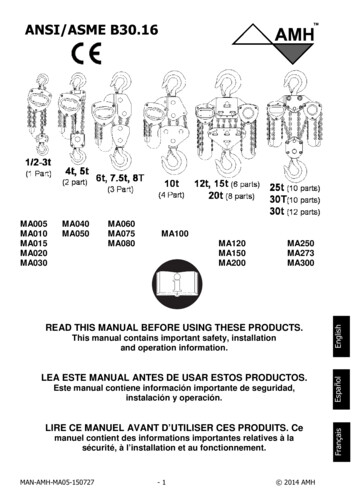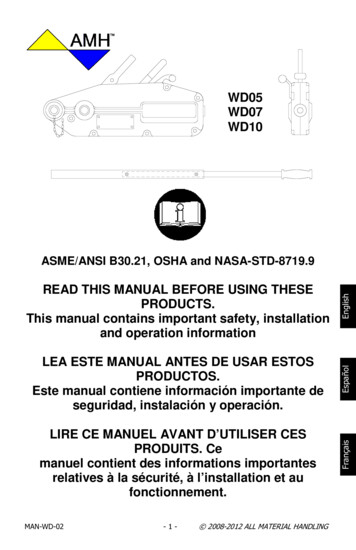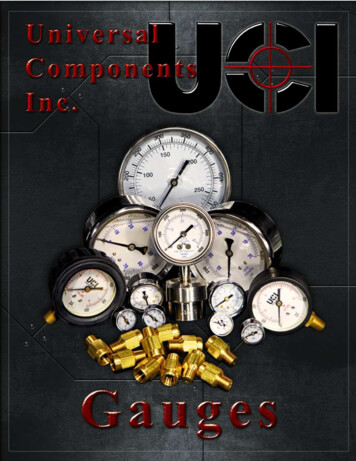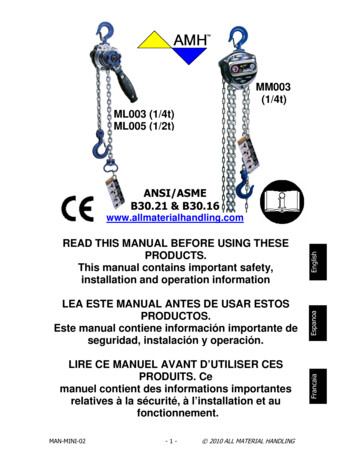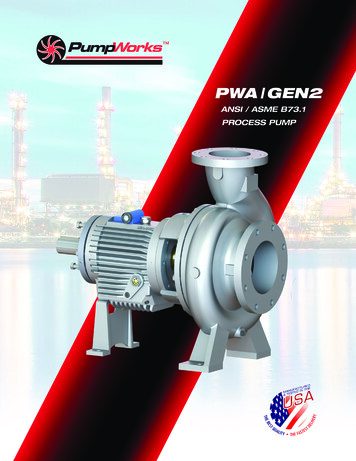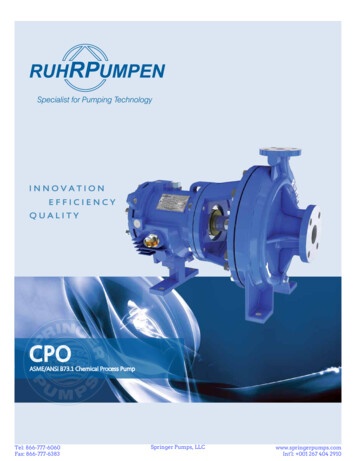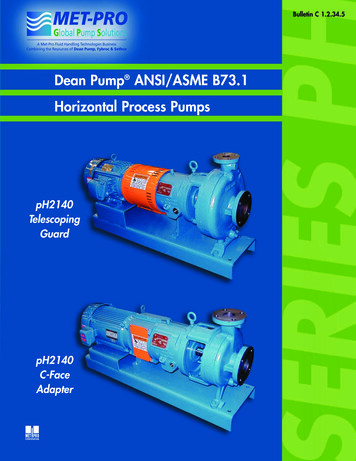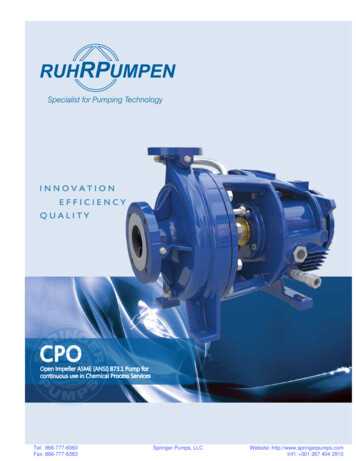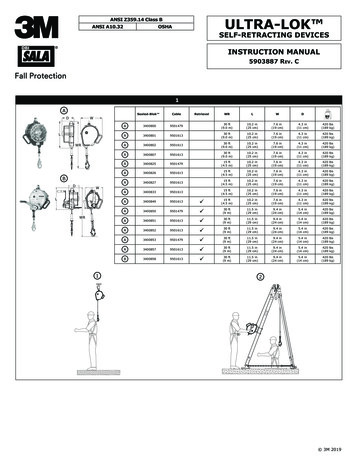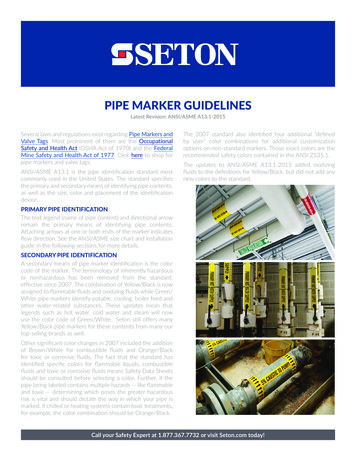
Transcription
PIPE MARKER GUIDELINESLatest Revision: ANSI/ASME A13.1-2015Several laws and regulations exist regarding Pipe Markers andValve Tags. Most prominent of them are the OccupationalSafety and Health Act (OSHA Act of 1970) and the FederalMine Safety and Health Act of 1977. Click here to shop forpipe markers and valve tags.ANSI/ASME A13.1 is the pipe identification standard mostcommonly used in the United States. The standard specifiesthe primary and secondary means of identifying pipe contents,as well as the size, color and placement of the identificationdevice.The 2007 standard also identified four additional “definedby user” color combinations for additional customizationoptions on non-standard markers. Those exact colors are therecommended safety colors contained in the ANSI Z535.1.The updates to ANSI/ASME A13.1-2015 added oxidizingfluids to the definitions for Yellow/Black, but did not add anynew colors to the standard.PRIMARY PIPE IDENTIFICATIONThe text legend (name of pipe content) and directional arrowremain the primary means of identifying pipe contents.Attaching arrows at one or both ends of the marker indicatesflow direction. See the ANSI/ASME size chart and installationguide in the following sections for more details.SECONDARY PIPE IDENTIFICATIONA secondary means of pipe marker identification is the colorcode of the marker. The terminology of inherently hazardousor nonhazardous has been removed from the standard,effective since 2007. The combination of Yellow/Black is nowassigned to flammable fluids and oxidizing fluids while Green/White pipe markers identify potable, cooling, boiler feed andother water-related substances. These updates mean thatlegends such as hot water, cold water and steam will nowuse the color code of Green/White. Seton still offers manyYellow/Black pipe markers for these contents from many ourtop-selling brands as well.Other significant color changes in 2007 included the additionof Brown/White for combustible fluids and Orange/Blackfor toxic or corrosive fluids. The fact that the standard hasidentified specific colors for flammable liquids, combustiblefluids and toxic or corrosive fluids means Safety Data Sheetsshould be consulted before selecting a color. Further, if thepipe being labeled contains multiple hazards -- like flammableand toxic -- determining which poses the greater hazardousrisk is vital and should dictate the way in which your pipe ismarked. If chilled or heating systems contain toxic treatments,for example, the color combination should be Orange/Black.Call your Safety Expert at 1.877.367.7732 or visit Seton.com today!
PIPE MARKERS OVER THE YEARSCURRENTANSI/ASME A13.1-2015 GUIDELINESTHE OFFICIAL ANSI/ASME A13.1-2015COLOR GUIDELINES STATES:“Color should be used to identify thecharacteristic hazards of the contents. Colorshould be displayed on, or contiguous to,the piping by any physical means, but itsuse shall be in combination with the legend.”FLUID SERVICECOLOR SCHEMEFire quenching fluidsWhite on RedToxic & corrosive fluidsBlack on OrangeFlammable & oxidizingfluidsBlack on YellowCombustible fluidsWhite on BrownPotable, cooling, boilerfeed, & other waterWhite on GreenCompressed AirWhite on BlueWhite on PurpleBlack on WhiteDefined by userWhite on GreyWhite on BlackOUTDATEDANSI/ASME A13.1-1996 GUIDELINESCLASSIFICATIONSUB CLASSIFICATIONCOLOR SCHEMEInherently HazardousMaterials– Flammable or Explosive– Chemically Active or Toxic– Extreme Temperature/Pressure– RadioactiveBlack on YellowLiquid or liquid admixtureWhite on GreenGas or gaseous admixtureWhite on BlueWater, loam, CO2, Halon, etc.White on RedInherently LowHazard MaterialsFire QuenchingMaterialsCall your Safety Expert at 1.877.367.7732 or visit Seton.com today!
PIPE MARKER GUIDELINESSETON PIPE MARKING SYSTEMS MEET THE ANSI/ASME A13.1 STANDARDAccording to the standard, pipe markers should be positioned so that they are readily visible to plant personnel from the point ofnormal approach. Seton pipe markers instantly tell you all you need to know about pipe contents, direction of flow and whetherthey’re hazardous or safe.HOW TO PROPERLY LABEL PIPES1. Obtain a legend list of all pipe contents in your plant.2. Collect the following data on your piping systems (this mayrequire tracing lines to determine quantities and sizes):– Pipe contents– Outside diameter of pipe (including insulation)– Quantity of markers needed per ASME/ANSI A13.1 orother standards– Pressure– Temperature– To/from information– Location of specific legends by area (for aid ininstallation)***Note: You may be able to use blueprints or P&IDsif they are current instead of walking down allof your lines. Seton also offers Take-Off Servicesto help you determine your pipe marking needs.3. Select color of marker.CHOOSING THE RIGHT PIPE MARKER1. SIZESeton pipe marking systems meet ANSI/ASME size recommendations.The A13.1-2015 standard also makes recommendations as to the size of letter height and length of color field for various pipediameters. These recommendations are shown in the table below. Seton markers, when used properly with arrows and bandingtape or arrow tape, meet or exceed the standard.FITS PIPE OUTERDIAMETERLENGTH OFCOLOR FIELDLETTERHEIGHT3/4” - 1-1/4” (19mm - 32 mm8” (203mm)1/2” (13mm)1-1/2” - 2” (38mm - 51mm)8” (203mm)3/4” (19mm)2-1/2” - 6” (64mm - 152mm)12” (305mm)1-1/4” (32mm)8” - 10” (204mm - 254mm)24” (610mm)2-1/2” (64mm)over 10” (over 254mm)32” (813mm)3-1/2” (89mm)Note: For pipes less than 3/4” in diameter, a permanently legible tag is recommendedCall your Safety Expert at 1.877.367.7732 or visit Seton.com today!
CHOOSING THE RIGHT PIPE MARKERFLUID SERVICECOLOR SCHEMEFire quenching fluidsWhite on RedToxic & corrosive fluidsBlack on OrangeDefinition of materials (from the official ANSI/ASME A13.12015 guidelines):Flammable & oxidizingfluidsBlack on YellowFire Quenching: This classification includes water, foam,and CO2 used in sprinkler systems and fire fighting pipingsystems.Combustible fluidsWhite on BrownToxic and Corrosive: This classification includes fluids thatare corrosive or toxic, or will produce corrosive or toxicsubstances when released.Potable, cooling, boilerfeed, & other waterWhite on GreenCompressed AirWhite on Blue2. COLORSeton pipe marking systems meet ANSI/ASME colorrecommendations.Unmarked pipes are dangerous to both life and property.Numerous injuries have occurred due to the ignorance of pipecontents, particularly when outside agencies are involved duringemergency scenarios.Flammable: This classification includes fluids, which, underambient or expected operating conditions, are a vapor orproduce vapors that can be ignited and continue to burn inair.White on PurpleCombustible: This classification includes fluids that can burn,but are not flammable.Oxidizing (new addition for 2015 standards): Oxidizing fluidis any gas or liquid that may, generally by providing oxygen,cause or contribute to the combustion of other material morethan air does.Black on WhiteDefined by userPotable, cooling, boiler feed and other water: Clean waterusable fordrinking, bathing, washing, can be oxidized and isnot harmful ortoxic in any way.Compressed Air: Air kept under a pressure that is greaterthan atmospheric pressure. Used for domestic and industrialpurposes.3. WORDINGOver 150 stock legends available!Still can’t find the wording you need? No problem: We cancustomize markers to your exact wording.Call your Safety Expert at 1.877.367.7732 or visit Seton.com today!White on GreyWhite on Black
CHOOSING THE RIGHT PIPE MARKER4. GHS PICTOGRAMSCommunicate hazard information with your Pipe Markers through GHS Pictograms.ASME A13.1 2015 incorporated GHS pictograms into the 2015 revision, recommending their use as part of the legend. Acorresponding piping label may be provided with pipes connected to containers labeled in accordance with GHS requirements.The corresponding label should contain at least the product name or identifier, the pictogram, the signal word and the physical,health and environmental hazard statement(s).Health Hazard– Carcinogen– Mutagenicity– Reproductive Toxicity– Respitory Sensitizer– Target Organ Toxicity– Aspiration ToxicityFlame– Flammables– Pyrophonics– Self-Heating– Emits Flammable Gas– Self-Reactives– Organic PeroxidesExclamation Mark– Irritant (skin and eye)– Skin Sensitizer– Acute Toxicity (harmful)– Narcotic Effects– Respiratory Tract Irritant– Hazardous to OzoneLayer (Non-Mandatory)Gas Cylinder– Gases Under PressureCorrosion– Skin Corrosion / Burns– Eye Damage– Corrosive to MetalsExploding Bomb– Explosives– Self-Reactives– Organic PeroxidesFlame Over Circle– OxidizersEnvironment Skull(Non-Mandatory)– Eye DamageSkull & Crossbones– Acute Toxicity(fatal or toxic)*The applicable GHS pictogram as illustrated may be included as part of the legend.GHS pictograms available for select pipe markers only.For more information on the ANSI/ASME A13.1-2015 Standard, please visit the followingthe American National Standards Institute online -scheme-identification-piping-systems-(1)For more than 60 years, Seton has served as the most trustedsource of pipe markers for architects, engineers, contractors andspecifiers. In fact, we’ve been written into more project specs thanany other company! Our OSHA-authorized contractor specialistsare available to help with all your project needs. Between theirhands-on experience in the field and unparalleled expertise,they will help you ensure your jobsites are safe, compliant andon budget. We’re proud to carry a wide variety of pipe markingproducts which are fully compliant with current ANSI standards aswell as customizable to meet the specific needs of your projects.Seton is the industry leader in pipe marking: See why for yourself.Call your Safety Expert at 1.877.367.7732 or visit Seton.com today!
ANSI/ASME A13.1 is the pipe identification standard most commonly used in the United States. The standard specifies the primary and secondary means of identifying pipe contents, as well as the size, color and placement of the identification device. PRIMARY PIPE IDENTIFICATION The text legend (name of pipe content) and directional arrow
